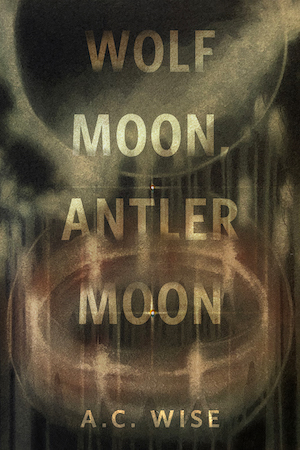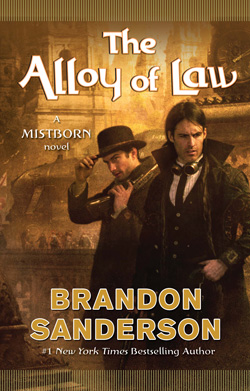Electricity lights the houses of noblemen, an Allomancer does well to keep their gun at the ready, and the railroad will take you most any place you want to go. Not bad for a fantasy world that was drowning in ash and mist and slavery just three hundred years before.
After reading The Alloy of Law, this kind of departure makes a lot of sense. Of course this would be where the Mistborn universe goes next. I’m on record here as greatly enjoying the first Mistborn novel, mostly due to how it subverts fantasy tropes while still giving the reader an exciting fantasy story. And Sanderson himself has gone on record as believing that fantasy as a genre can encompass any other genre that an author feels fit to instill within it.
The Alloy of Law, out today, is the money put into that particular mouth.
(This is mainly an appreciation of The Alloy of Law, so I’ll be avoiding spoilers, although a few hints may creep in here and there.)
Thanks to the fact that a substantial portion of the book has been available for months, the basic story of The Alloy of Law is pretty much already out there. Nobleman and vigilante(-ish) lawman Wax and his less scrupulous friend Wayne are on the heels of a band of thieves that are kidnapping women, metals, and objects of wealth. The actions draw Wax out of a self-imposed exile in the Roughs after twenty years because this time, it’s personal.
Of course, it’s not too long before one discovers that not only is this personal, it’s bordering on societal. Because even though the world of Mistborn has grown out of its epic fantasy environment and into a steampunk-ish western, this is still intrinsically a fantasy novel.
The Alloy of Law proves this in three ways:
1.) Something is wrong and our heroes are risking everything to stop it. Granted, this is a common character motivation in any adventure story, but epic fantasy’s most well-known tales tend to be ones that spin a personal struggle against an evil and expand it into a worldwide effort. Elves and men just need to distract Sauron long enough for Frodo to destroy the Ring. Rand needs to unite the world against the Shadow. And even in Mistborn, Kelsier, Vin, and Elend start out by opposing a corrupt government but end up fighting against entropy itself.
The Alloy of Law starts out as a personal fight, but the corruption Wax uncovers goes far deeper than just his little corner of the world.
2.) The world is a direct result of the events and battles that came before it. The original Mistborn trilogy is everywhere in The Alloy of Law, both environmentally and overtly. It won’t throw off a reader that’s new to the series, but those who have read the original trilogy will see the affects of that series all throughout the novel. The world of Mistborn continues to build, even in this somewhat tangential tale.
Sanderson has spoken online (and he repeats it in this novel) that Mistborn was meant to be more than one trilogy; that the story ultimately follows a fantasy world as it grows through different periods of time and genres. When the book is closed on the world of Mistborn, its saga might be ten or twelve books long, and The Alloy of Law is only the beginning of the widening of that particular scope.
3.) Magic exists, and it just becomes all the more interesting as technology progresses. When it was first announced that The Alloy of Law was taking place in a world roughly equivalent to late 1800s/early 1900s America, I was very excited. A metal and physics-based magic system can do a lot with swords and castle walls and whatnot, but it can do serious damage in a world full of guns, railroads, and burgeoning commercial skyscrapers. The change in setting and the introduction of technology made me focus on the magic and rules of the Mistborn fantasy world all the more. Magic propels the action and informs the story just as much as it was in the original trilogy.
And it’s going to be even more exciting to see this series enter its own internet age. What roles do Allomancers and Feruchemists and Twinborns and Mistborns have in an age where power is information and information is stored on metal?
It’s just as exciting to imagine this series entering a spacefaring science fiction age. Would Allomancy kick off space travel earlier? Would it make it more effective? Would you only get to go into space if you’re an Allomancer? Would they get so in-depth with the study of these physics-based powers that they would figure out artificial gravity and FTL drives?
The Alloy of Law doesn’t answer those questions. How could it? But it does get you thinking about those kinds of scenarios after the story is told. It gets you imagining where else fantasy can go.
(And after that final chapter, it also gets you wondering what’s [SUPER REDACTED SPOILERS].)
A quick note: We have a proper Alloy of Law spoiler thread here, so let’s keep the below comments spoiler-free. Anything up to the already-posted excerpts is fair game.
Chris Lough is the production manager of Tor.com and left his cowboy boots in his other time machine.










